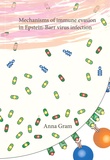Mechanisms of immune evasion in Epstein-Barr virus infection

Gram, Anna
- Promoter:
- Prof.dr. R.C. (Rob) Hoeben & prof.dr. E.J.H.J. (Emmanuel) Wiertz
- Co-promoter:
- Dr. M.E. (Maaike) Ressing
- Research group:
- Wiertz
- Date:
- September 8, 2016
- Time:
- 11:15 h
Summary
The human herpesvirus Epstein-Barr virus (EBV) is a large DNA virus that infects over 90% of the adult world population. EBV is the causative agent of infectious mononucleosis and EBV infection is associated with various malignancies. EBV establishes lifelong infections in immunocompetent hosts. EBV has acquired strategies to counteract the host’s immune defense. During latency of EBV, viral protein expression is limited or absent, thereby being virtually invisible to the immune system. Evasion strategies of EBV active during primary infection or upon reactivation are considered beneficial for establishment of latent infection or prolonged replication, respectively. Viral molecules interfering with antigen presentation by HLA I and HLA II have been identified previously. The aim of this thesis was to identify novel molecules directing immune evasion and investigate the respective underlying molecular mechanisms, thereby contributing to our understanding of EBV and the human immune system.
We described a shRNA-based approach to silence the shutoff protein BGLF5 in lytically EBV-infected B cells in order to unmask novel evasion targets of EBV. The non-classical lipid-presenting molecule CD1d was identified as a new target of BGLF5. Furthermore, the data suggested that likely additional mechanisms exist in EBV targeting CD1d. We identified one of these molecules, EBV gp150. EBV gp150 appears to shield antigen-presenting molecules and other surface molecules on B cells by means of its abundant glycans. Thereby, EBV gp150 impairs T cell recognition of infected cells. Furthermore, the allele specificity of the previously identified HLA I evasion molecule EBV BILF1 was investigated. Thereby, the molecular requirements in HLA I as well as in BILF1 that are needed for immune evasion were identified. Recent advances in the field of DNA sensing led to the question whether B cells might sense foreign DNA by the cGAS-STING pathway. We described the expression profile and function of cytosolic DNA sensors in B cells, the main target cells of EBV persistence.
The work described in this thesis shows that EBV employs several molecular mechanisms to interfere with antigen presentation of classical and non-classical antigen presenting molecules. Understanding these mechanisms may aid in developing therapies for EBV-associated diseases.